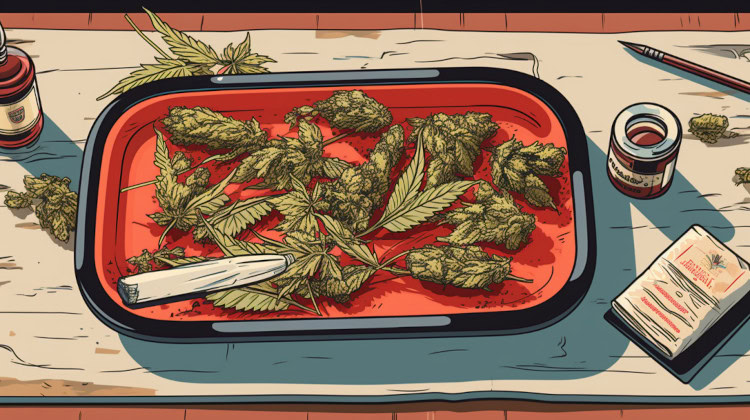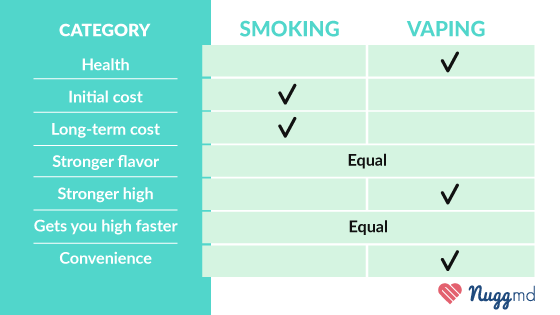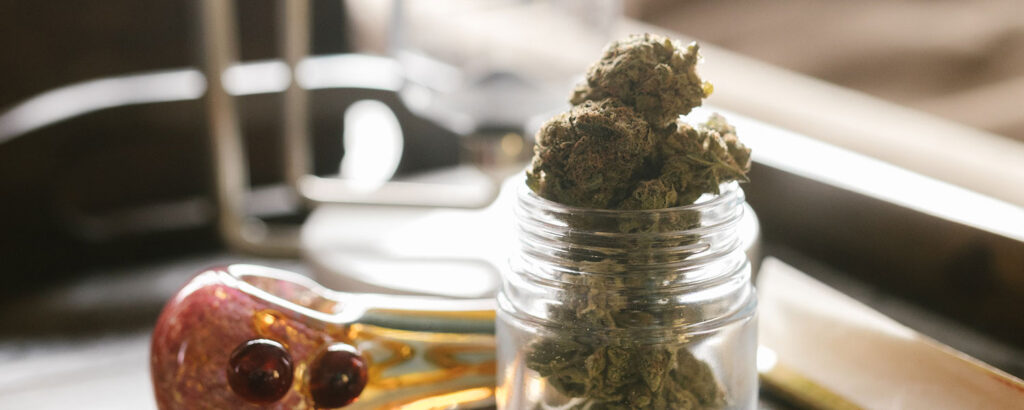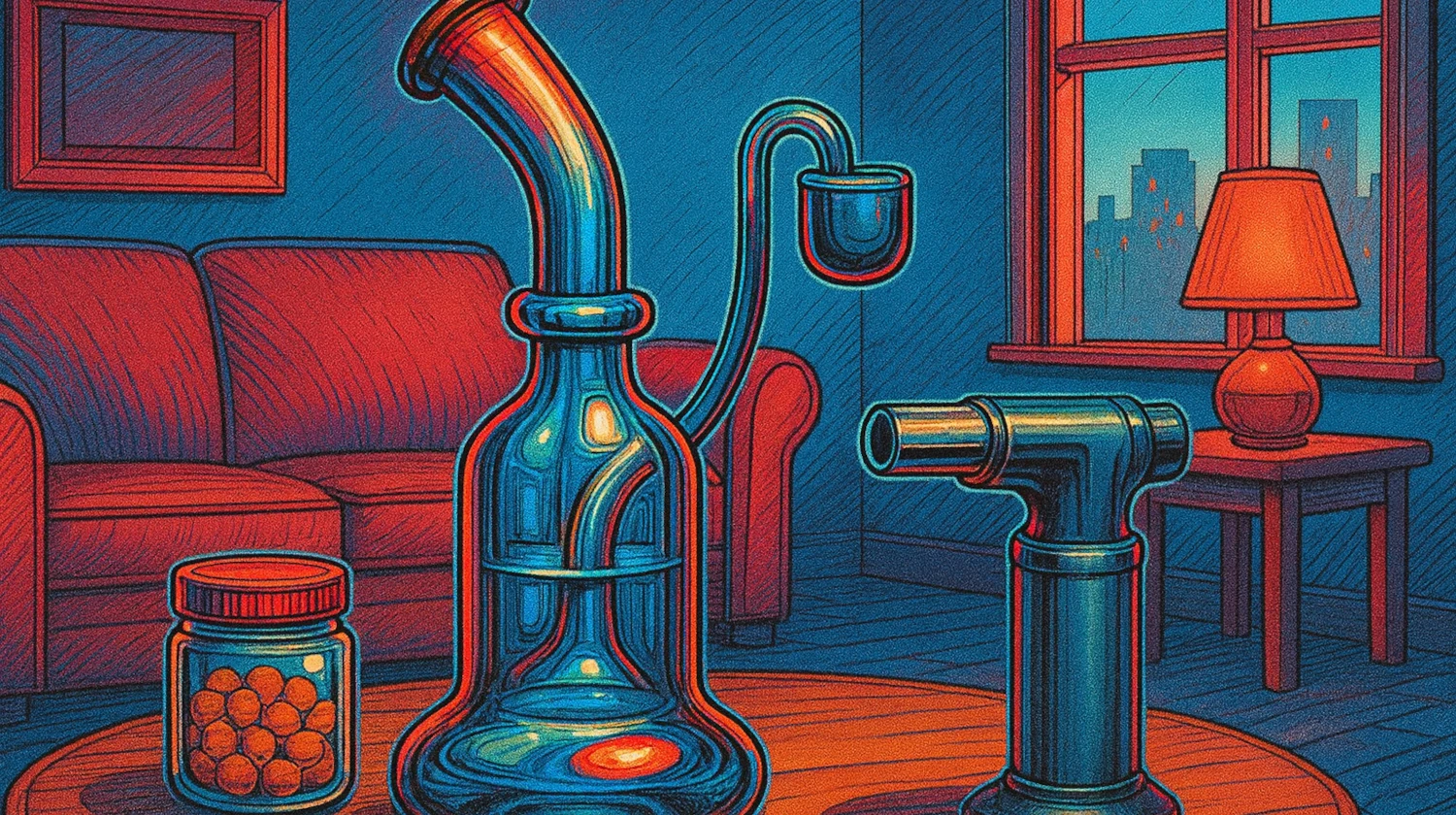In This Article
- Vaping vs Smoking Weed: Which is Healthier?
- What are the Health Effects of Smoking Weed?
- What are the Health Effects of Vaping?
- Vaping vs Smoking Weed: Which Has a Better High?
- Potency
- Duration
- Sensation
- Vaping vs Smoking Weed: Which is More Cost Effective?
- How Long Does a Cart Last vs. Flower?
- Possible Equipment
- Cost
- Vaping vs Smoking Weed: Which is More Convenient?
- Vaping vs Smoking Weed: Legal Status
- Vaping vs Smoking Weed: Summary
- References
Smoking is the oldest form of cannabis consumption. For thousands of years, different civilizations worldwide have smoked cannabis for social, recreational, or medicinal purposes.
Around 2001, another way of consuming cannabis came on the scene: vaping. The fast-growing popularity of vaping has led to a wave of growing technology over the years, ranging from the Volcano and its giant plastic bags to dab rigs and more portable vape pens. While many vaporizers are known as nicotine devices, cannabis has become more popular in recent years.1 Today, vaping is often seen as the third most popular consumption product sold, behind dried flower and edibles.2
Is vaping worse than smoking weed? Is it better?
Vaping vs Smoking Weed: Which is Healthier?
The vaping vs smoking weed debate often boils down to the healthier option. Health is and should be a primary concern for everyone. Still, the subject is nuanced.
With the research conducted so far, vaping is often considered a less harmful method of consumption compared to smoking.3 However, vaping consumers must be aware of their temperature settings, or they risk discovering first hand if vaping is worse than smoking weed.
What are the Health Effects of Smoking Weed?
Smoking involves the inhalation of burnt cannabis flower smoke. To many, smoking is considered the most harmful method of consumption.
Smoke of any kind can contain harmful chemicals, including carcinogens. These toxins and carcinogens can irritate your respiratory system. Over time, this can lead to more chronic and severe medical concerns, including various types of cancer. While smoking nicotine tends to be more associated with adverse results, cannabis smokers are also advised to heed the warnings.
Additional health concerns related to smoking can include an increased risk of numerous medical conditions, such as bronchitis, lung infections, a chronic cough for prolonged periods, increased mucus buildup, and more.
Remember that when you smoke weed, you also expose yourself to possible derivatives associated with your joints, blunts, pipes, or otherwise and – possibly inhaling additional compounds, including toxins found in tobacco wraps, resin, and other sources.
What are the Health Effects of Vaping?
Vaping involves inhaling and exhaling an aerosol or vapor from a heated cannabis-derived extract. Often consumed through a dab rig or a vape pen, the oil is heated until it vaporizes and can be inhaled. This method avoids inhaling more toxic carcinogens while also preserving much of the plant’s terpene profile, helping increase its potency. Vaping typically minimizes the risk of exposure to toxins and carcinogens, reducing the risk of developing chronic respiratory symptoms or more severe medical outcomes.
However, consumers can put themselves at risk of carcinogen and toxin exposure if they heat their oil to the point of combustion. As such, it is recommended that consumers consume low-temperature dabs to avoid exposure to harmful compounds.4 Consumers can also find themselves at risk if they buy unlicensed vape products. This is evidenced by the deadly EVALI vape crisis of 2019 and 2020, brought on by illicit products cut with vitamin E acetate.
Most vape consumers won't have to worry about combusting oil when using a temperature-controlled device, such as a vape cartridge and battery or an e-nail with their dab rig. Those using a torch will want to keep their temperatures in check by avoiding blasting their nail with too much heat or not giving the surface time to cool before placing the concentrates on it.
While the jury is still out, current clinical research suggests that vaping could be a healthier alternative in many cases, considering that consumption happens at lower temperatures.
Vaping vs Smoking Weed: Which Has a Better High?

Beyond health, consumers also want to pick an option that provides the best high. Determining which product best fits a consumer’s lifestyle should include the potency and duration of its effects. There are some overlaps between smoking and vaping weed, but there are also differences to be aware of.
Potency
Potency varies significantly between smoking and vaping, with the latter delivering a more potent concentration of cannabinoids every single time. Concentrates develop higher levels of THC during the extraction process. The increased dosage of cannabinoids may explain why some studies have found that vaping produces a more significant effect change on consumers.5
Duration
The length of effects should be relatively the same between smoking and vaping. In most cases, the effects will last three hours or less. Remember that various factors, including strain, dosage, and tolerance level, will all influence the outcomes and potentially the duration of the high.
Sensation
Sensation and outcome are often subjective in the world of cannabis. Each person will experience the plant differently. Cannabis delivers some uniform effects, but several factors impact an individual's outcome. This makes it difficult to pinpoint specific sensations created by vaping or smoking. However, with more significant effects felt from vaping, sensations may increase compared to smoking weed.6
When determining which has a better high, consumers need to decide that for themselves. Firsthand feedback is essential to choose, but use this information to prepare. Beginner consumers or those who have a low tolerance should consider starting with smoking weed or taking tiny hits from a vape pen. This should help avoid the higher dosage and possibly increase the effects and sensations linked to vaping.
Vaping vs Smoking Weed: Which is More Cost Effective?
Cost plays a significant factor for most consumers when choosing between smoking and vaping. Consumers can choose from vape cartridges, dried flowers, and vaping dried flower with certain devices. Some devices are also equipped to handle both oil and dried flower vaping.
How Long Does a Cart Last vs. Flower?
It is challenging to give an exact answer to how long a vape cart or flower lasts. It boils down to how often a consumer uses each product. Consumers should note their own consumption lengths to understand their personal needs and how often they’ll need to purchase products.
Possible Equipment
Equipment will vary depending on the preferred consumption method and the setup size. Smoking cannabis can be as portable as a joint or as elaborate as a piece of glass to smoke out of. Depending on if you're rolling a joint, packing a bowl, or smoking a bong, these are some of the most common pieces of equipment you may need:
- Rolling paper or blunt wrap
- Lighter
- Grinder
- Bong, bowl, or water pipe
- Rolling tray
- Ashtray
Vaping is now as portable as smoking cannabis. It can be as easy as only a pen or as complex as setting up with a massive rig. These might be some of the possible pieces of equipment needed:
- Torch or e-nail
- Vape pen
- Dabber
- Carb caps
- Quartz bangers
- Q-tips
- Isopropyl alcohol
- Dab mat
Cost
Both options present similar wide ranges of average costs associated. Vape pens can vary wildly in cost, easily found starting at $50 or more at smoke shops. A more elaborate dab rig may cost several hundred dollars. Usage factors greatly into the cost, with consumers able to buy single-use disposable vapes and batteries that can be used numerous times with a recharge.
Smoking costs can also vary greatly. Accessories can run just a few dollars for rolling papers and a lighter. Experienced consumers can also invest hundreds of dollars, if not more, into elaborate devices like bowls and bongs. Smoking cannabis comes with single-use or reusable items of all sorts. Smoking joints and blunts provide a one-and-done disposable smoke, while bowls, bongs, and many other pieces are all intended for multiple uses.
Vaping vs Smoking Weed: Which is More Convenient?

Convenience boils down to opinion. Some people love setting up dab rigs and rolling joints. Others want to take a quick hit from a pen or smoke a pre-roll without any of the work. Ultimately, it comes down to personal preference, depending on the situation.
There is convenience and ease of use for each method. However, the level of discretion and social acceptability in the area should be considered. Some areas of the country still prohibit smoking weed and consuming it in public may not be a wise choice. Even in some legal areas, the stigma against smoking may still be strong. For many reasons, discretion is ideal in many instances. Having an odorless vape is more ideal for some than smoking in many places.
Also, consider the list of tools needed to consume cannabis. A consumer may need to carry many items and that may not be easy to handle in public. You may love dabbing from a traditional rig or smoking from your favorite water pipe, but will they be easy enough to carry around outside of the home, or is a handheld device better for portability and possible discretion?
Vaping vs Smoking Weed: Legal Status
Not all states with medical cannabis programs allow smoking and/or vaping weed. Before you plan your first trip to the dispensary with your new med card, take a moment to check your state’s medical cannabis program website (and the menus of state-licensed dispensaries).
As of April 2024, here's the legal status of cannabis smoking and vaping in the US:
| Allows smoking of cannabis flower for adults or medical patients | Allows vaping of cannabis flower or oil for adults or medical patients | Doesn't allow medical cannabis, OR restricts products to low THC |
| Alaska | Alaska | Alabama |
| Arizona | Arizona | Georgia |
| California | California | Idaho |
| Colorado | Colorado | Kansas |
| Connecticut | Connecticut | Nebraska |
| Delaware | Delaware | North Carolina |
| District of Columbia | District of Columbia | South Carolina |
| Florida | Florida | Tennessee |
| Guam | Guam | Texas |
| Hawaii | Hawaii | Wisconsin |
| Illinois | Illinois | Wyoming |
| Louisiana | Kentucky (Starting Jan 2025) | |
| Maine | Louisiana | |
| Maryland | Maine (oil and vape pens are not allowed) | |
| Massachusetts | Maryland | |
| Michigan | Massachusetts | |
| Mississippi | Michigan | |
| Missouri | Mississippi | |
| Montana | Missouri | |
| Nevada | Montana | |
| New Hampshire | Nevada | |
| New Jersey | New Hampshire | |
| New Mexico | New Jersey | |
| New York | New Mexico | |
| North Dakota | New York | |
| Ohio | North Dakota | |
| Oklahoma | Ohio | |
| Oregon | Oklahoma | |
| Pennsylvania | Oregon | |
| Puerto Rico | Pennsylvania | |
| Rhode Island | Puerto Rico | |
| South Dakota | Rhode Island | |
| U.S. Virgin Islands | South Dakota | |
| Utah | U.S. Virgin Islands | |
| Vermont | Utah | |
| Virginia | Vermont | |
| Washington | Virginia | |
| Washington | ||
| West Virginia |
Vaping vs Smoking Weed: Summary

The vaping vs smoking weed debate will certainly be discussed for years. As more research is conducted, each method is being understood more, along with the cannabis market maturing and regulations changing.
Research currently suggests that vaping is often a healthier form of consuming cannabis, as long as the temperatures are kept below combustion levels. Those looking for more substantial potencies should also turn to vaping. Ultimately, the choice boils down to the consumers' preference. Smoking and vaping have uniform results, but each person experiences cannabis differently. At the same time, not every cannabis strain is the same. Combining the myriad of differences between each person and each plant, it is difficult to say which is better.
Consumers can use the clinical studies to compare them to their ideal outcomes and budget. These factors, and many more, will help you determine which is truly better.
References
- Meehan-Atrash J, Rahman I. Cannabis Vaping: Existing and Emerging Modalities, Chemistry, and Pulmonary Toxicology. Chemical Research in Toxicology. 2021;34(10):2169-2179. doi:https://doi.org/10.1021/acs.chemrestox.1c00290 ↩︎
- Steigerwald S, Wong PO, Cohen BE, et al. Smoking, Vaping, and Use of Edibles and Other Forms of Marijuana Among U.S. Adults. Annals of Internal Medicine. 2018;169(12):890. doi:https://doi.org/10.7326/m18-1681 ↩︎
- Chaiton M, Kundu A, Rueda S, Di Ciano P. Are vaporizers a lower-risk alternative to smoking cannabis?. Can J Public Health. 2022;113(2):293-296. doi:10.17269/s41997-021-00565-w ↩︎
- Meehan-Atrash J, Luo W, Strongin RM. Toxicant Formation in Dabbing: The Terpene Story. ACS Omega. 2017;2(9):6112-6117. doi:https://doi.org/10.1021/acsomega.7b01130 ↩︎
- Lucas CJ, Galettis P, Schneider J. The pharmacokinetics and the pharmacodynamics of cannabinoids. British Journal of Clinical Pharmacology. 2018;84(11):2477-2482. doi:https://doi.org/10.1111/bcp.13710 ↩︎
- Spindle TR, Cone EJ, Schlienz NJ, et al. Acute Effects of Smoked and Vaporized Cannabis in Healthy Adults Who Infrequently Use Cannabis. JAMA Network Open. 2018;1(7):e184841. doi:https://doi.org/10.1001/jamanetworkopen.2018.4841 ↩︎
The information in this article and any included images or charts are for educational purposes only. This information is neither a substitute for, nor does it replace, professional legal advice or medical advice, diagnosis, or treatment. If you have any concerns or questions about laws, regulations, or your health, you should always consult with an attorney, physician or other licensed professional.




